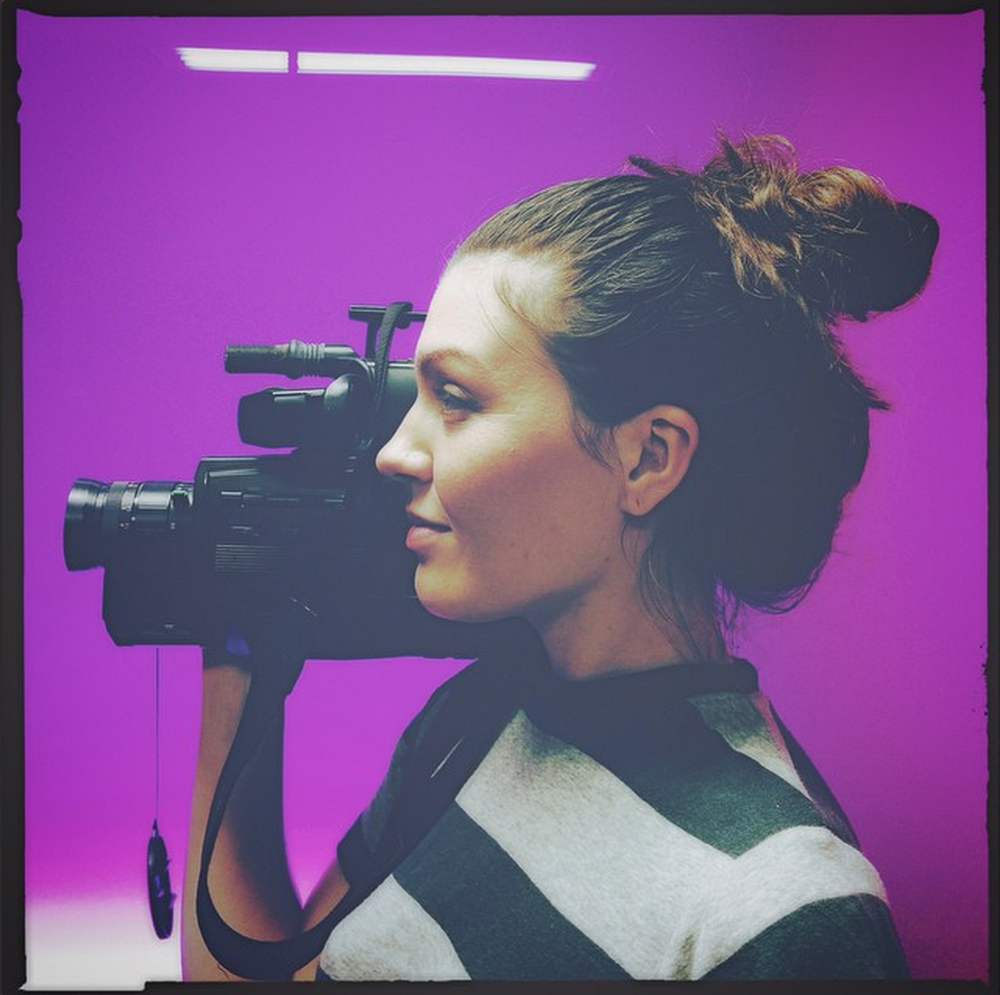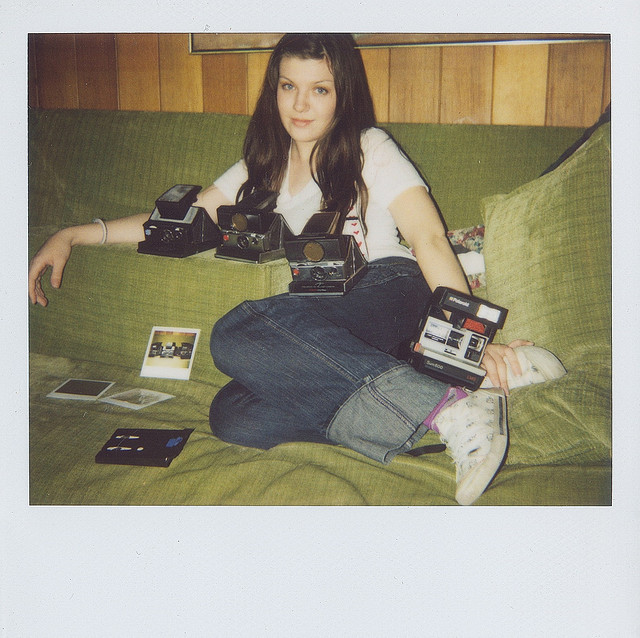After conducting our interview with Australian band Atlas Genius’s frontman Keith Jeffery, we decided to take it a step further and talk to a woman who’s played a big part behind the scenes in the band’s success. Claire Marie Vogel is a director, editor and photographer from California who took her first leap into the music video world with her impressive debut video for Atlas Genius’s “Symptoms.” Since then she has gone on to create two more videos with the band, forming a close knit relationship with them both in and out of music. Additionally she has collaborated with The Red Hot Chilli Peppers, Deftones, My Chemical Romance and more. Check out what she had to say about her introduction to film work, her success in the world of music videos, and her plans for the future, below.
John: How did you get started? Is making music videos your full time jam?
Claire: No, not necessarily. I direct music videos on my own, I’m repped by a production company, and I also have a full time job at Warner Bros records where I work as an in-house director, editor, photographer and videographer. I work with the all of the departments to create content from top to bottom for WB artists. Occasionally it does involve directing music videos, but that’s usually because, like with Atlas Genius, I have a connection with the band and we’ve worked together a lot and it grows into something greater.
J: What are your your aspirations? More music videos? Or are you trying to transition into other lanes like feature films?
C: I didn’t get into music videos to move onto something else. Not to say that I don’t want to do other things, but I always see myself making music videos. Music has always been a big driving force for creating visuals. Combining music and images together makes it’s own kind of magic. So, I don’t really see all of that going away, but I am really interested in documentary work and experimental essay films. I would love to do narrative films at some point too, but it’s not something I’m actively trying to do at this moment. J: Why not?
J: Why not?
C: I feel like it’s just not what drives me really, at least right now. There’s so many people I know who have that as a very clearly defined goal – to make narrative work. I think I definitely tell stories and want to tell more stories, but maybe in a more experimental, nonfiction way. That can definitely be done in feature films and narrative films, but I guess I’m still figuring out my own way to do that. I enjoy making music videos and that’s the most enjoyable way for me to express myself right now. I’m still growing there too. I’m looking to make a jump to other things very soon, but definitely going to continue doing music videos.
J: You say you’re telling a nonfiction story in this other way, but there’s narrative in your music videos. On one side there’s sort of performance art and the use of graphical elements and projecting onto the artist and so forth and a very literal part of that. Then there’s these kind of very nostalgic moments where it seems like you’re inserting in these kind of sketches or stories you have from your life or from the artist’s life. At least that’s what it looks like from the outside. Is that there or am I imagining that?
C: No, that’s very true. I think maybe what’s so appealing about music videos is that it feels like the perfect platform for combining different forms of story-telling, that provides so many opportunities to experiment, and is a way to express things I’m going through. I’m sure I could find a way to fit all of that into a more formally narrative short story or longer form film, but this has been a great platform to try all of that out.
J: How did you fall into this medium? How did you end up here?
C: My last years of high school were spent in Laguna Beach where I had a very close knit group of friends who were musicians. Many have since gone on to do really amazing things and some I’ve made music videos with since then. We were always hanging out and often playing music and I was constantly photographing or filming just to capture the moment. My obsession with documenting the little moments turned into “let’s make a music video!”, and after doing that, I realized music videos were a great way to express myself. I kept doing that and eventually I started making them with bigger artists. J: What’s your process, particularly with Atlas Genius? I interviewed Keith two days ago and asked him about the music videos and how they came to be. He said he had been shuffling around with some pretty poor product, especially relative to what he was spending on it. I’d love to hear about that relationship and how that translates into the ideation process, how you start with an artist (is it conversation or creative briefed?), and how that finds its way into the script, then the final cut?
J: What’s your process, particularly with Atlas Genius? I interviewed Keith two days ago and asked him about the music videos and how they came to be. He said he had been shuffling around with some pretty poor product, especially relative to what he was spending on it. I’d love to hear about that relationship and how that translates into the ideation process, how you start with an artist (is it conversation or creative briefed?), and how that finds its way into the script, then the final cut?
C: Atlas came to Warner Bros. three or four years ago. I was told there was a band coming in that day, and that I should film them arriving to the building. I met them as they pulled into the parking lot at Warner. I had a camera out filming these poor guys as they were getting out of the car and walking in for the first time. I spent the week filming with them and by the end of it a friendship had grown. Soon after that, they were looking to make multiple videos for songs from their album and I was asked to write a treatment for one. I really connected with “Symptoms” and wrote a treatment for that based some experiences I was having at the time, which I felt were reflected in the song. I got the go-ahead to make the video and because there was such a low budget for those first couple videos, the process was pretty hands-off and I had a lot of freedom. So, I went out and made “Symptoms” with a small crew and had a really great time. It’s still one of my favourite videos. I think everyone was pleasantly surprised with the outcome, which began a more creative relationship with the band. The video for Trojans was being filmed…
J: And it sucked. (Laughs)
C: (Laughs) It didn’t work out, it didn’t work out. So, they took into account what I did with “Symptoms” and we talked about what they wanted for “Trojans”, and what I would do with it. We decided to make a new video with a smaller budget, and pulled some of the camera crew together from the “Symptoms” video and made “Trojans.”
J: What’s a shoestring budget for something like “Symptoms” in your world?
C: (Laughs) I’m kind of scared to say how small that money was. (Laughs) Uhhh, it was $1500. It was so long ago now I don’t mind saying it. When you’re starting out there are favors you can ask and people that are willing to help to be a part of certain projects. So it’s definitely possible to do a lot with a little, but it was a huge effort from many people to do so.
J: I loved the opening horizontal banding shot (in Symptoms). What did you shoot it on? Did you shoot this on a DSLR?
C: No this was shot on a (RED) Epic. What you’re seeing is the rolling shutter paired with super slow motion, plus a light that we threw on it. We were experimenting to enhance the hypnotic state this kid is in, and set the tone for the surreal qualities of the video.
J: What was the general story for “Symptoms” and how did you end up starting with that kind of opening, which I think is a bold way to enter into a music video. Did that happen in the edit room or did the video exist exactly how you storyboarded it?
C: I don’t really storyboard in the linear sense too much. I find a lot of the story in the edit. It causes me a lot of headache, but it tends to fall together more organically that way because of the way I shoot and the way I enjoy to have a spontaneous vibe on set. I prefer to create outlines of what I’d like to shoot and then leave room on set for experiemenation. So, no, I didn’t plan for that to be the first shot, it was something that happened in the edit. I chose it because I felt this video is really about this boy’s fixation on this girl and how overwhelmingly romanticised his vision of the situation is, and how dramatic it is for him. I felt there’s this great yearning in his eyes at that moment, and you’re almost in his head at the same time.
J: Do you typically like to play with practical or “in-camera effects”, or are you mostly a post person when you apply these different effects?
C: I’m definitely a practical effects person, I don’t really do post work. I always feel in-camera effects are more organic and fit in more with the types work I’m making. J: What did you grade the video with?
J: What did you grade the video with?
C: Final Cut. I colored most of my videos with final cut up until a couple of months ago.
J: What did you move onto?
C: Premiere. The render difference is life changing.
J: What was it like delivering this project to the Atlas Genius guys? Do you screen it for them in a fancy theatre setting, is there any special way you go about screening videos for people?
C: Hmmm, no, usually you just make a private link and send it out. It’s not a very glamorous process I guess! After that, you hear feedback and it’s not always straightforward. Many people are emailing you their thoughts as well as other people’s thoughts (and so on). And especially when you work inside the record label – sometimes you have people walking into your office telling you their thoughts, and you don’t necessarily want to hear them. (laughs) So, it can be a little strange, specifically in my situation.
J: Yeah I mean that sounds stifling to me to have people walk in on the middle of your cut like ‘yeah that doesn’t look right.’
C: Oh yeah, and it’s happened many times in the past. I generally don’t show rough cuts though. I stay in my office and don’t let anyone see it until it’s done. Basically when I get to the point of ‘I don’t know what more to do with it’, then I will have someone else look at it. Now that I’m part of a more formal production team, the layers of the process have been developing more clearly.
J: When you produced Molecules for example, what is Atlas Genius’s objective with these music videos? Is it a collaborative piece with you as a friend? is it a marketing piece?
C: I think it’s definitely both because that’s just what it is, that’s why they’re spending money to make a video. I think their definitely celebrating the song in a way, but videos are a huge tool in promoting a song for record label as well. With Atlas being friends who I also work with, the process was a little different than normal. They told me that they wanted to make the video with me instead of going out and getting a bunch of treatments from various directors. It was very complimentary for them to do that, and we through about 4 treatment ideas before we got the one you see now.
J: All these friends have become franchises in a way, real entities, where it sounds like you don’t have to pitch the business. Your process sounds like it’s evolved with these bands. Is that true?
C: Yes and no. (For Atlas Genius) I think because it was the second album there was more pressure for the video to be something really specific. It felt like there were many more cooks in the kitchen in terms of what the concept should be, how they should look, etc. I think it was actually more challenging that way. It was still fun and collaborative, and at the same time it was different because it was further along in both of our careers.
J: I feel like there’s a lot of data in the new project, both the music video for “Trojans”, and the actual music. Did you get the sense there was more at risk, more chips on the table this time around?
C: Yeah absolutely, I definitely got that vibe. I think I felt a certain amount of pressure with the Trojans video, but at the same time we were all working together to make something different than what had been made and doing the best we could. There was a different type of pressure for the “Molecules” video because it was the first single and first video for the new album.
J: It is unique that they are in this video and not the other one. The other videos are outside, more open, this one you’re looking at a house in a studio, with the outside projected onto it. Visually it’s clear that there’s been a process here, that things have changed, that there’s a very different thing happening. Were you given a sort of checklist that included that they had to be in the video?
C: It wasn’t really a checklist, it was more that “Molecules” was the first video of the album and people wanted to see them. As Atlas hadn’t done a lot of videos that included performance, it seemed like a good place to start, so all of the treatments included the Keith and Mike.
J: If Keith were to do an experimental project and Atlas Genius were to put out a sort of experimental sound project would you shoot that?
C: Yeah! I mean, it’s always a matter of connecting with the song first and foremost for me. I’m usually very happy and hugely complimented when any artist wants to work together or work together multiple times. I really enjoy that continued collaborative relationship.
J: Great, thanks Claire! Appreciate you for chatting to us!